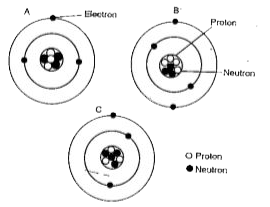What is an atom ?
Step-by-Step Solution:
1. Definition of an Atom:
An atom is defined as the smallest particle of matter. It is the fundamental building block of all substances.
2. Indivisibility of Atoms:
Atoms are considered indivisible, meaning that they cannot be divided into smaller particles through chemical means. When you keep dividing a substance, you will eventually reach a point where you cannot divide it any further, and that point is the atom.
3. Size of Atoms:
Atoms are extremely small. Their size is so tiny that they cannot be seen with the naked eye or even with most microscopes. They are smaller than anything we can typically imagine or compare.
4. Atoms as Units of Matter:
Atoms are the smallest units of ordinary matter that can exist independently and can combine with other atoms to form chemical elements. Each element on the periodic table is made up of a specific type of atom.
5. Summary:
In summary, an atom is the smallest, indivisible unit of matter that forms the basic building blocks of chemical elements.
An atom is defined as the smallest particle of matter. It is the fundamental building block of all substances.
Atoms are considered indivisible, meaning that they cannot be divided into smaller particles through chemical means. When you keep dividing a substance, you will eventually reach a point where you cannot divide it any further, and that point is the atom.
Atoms are extremely small. Their size is so tiny that they cannot be seen with the naked eye or even with most microscopes. They are smaller than anything we can typically imagine or compare.
Atoms are the smallest units of ordinary matter that can exist independently and can combine with other atoms to form chemical elements. Each element on the periodic table is made up of a specific type of atom.
In summary, an atom is the smallest, indivisible unit of matter that forms the basic building blocks of chemical elements.
Topper's Solved these Questions
- ATOMS , MOLECULES AND IONS BOOK - BHARATI BHAWAN (ENGLISH)CHAPTER - ATOMS , MOLECULES AND IONS EXERCISE - Short Answer Questions
14 Videos
- ATOMS , MOLECULES AND IONS BOOK - BHARATI BHAWAN (ENGLISH)CHAPTER - ATOMS , MOLECULES AND IONS EXERCISE - Numericals
16 Videos
- ATOMS , MOLECULES AND IONS BOOK - BHARATI BHAWAN (ENGLISH)CHAPTER - ATOMS , MOLECULES AND IONS EXERCISE - Mark the statements True (T) and False (F)
9 Videos
- ATOMIC STRUCTUREBOOK - BHARATI BHAWAN (ENGLISH)CHAPTER - ATOMIC STRUCTUREEXERCISE - D. Long Answer Questions
12 Videos
- ATOMS, MOLECULES AND IONS BOOK - BHARATI BHAWAN (ENGLISH)CHAPTER - ATOMS, MOLECULES AND IONS EXERCISE - E. Numericals
6 Videos
Similar Questions
Knowledge Check
Electronic confriguration of a transition element X in +3 oxidation states is [Ar]3d5.
What is its atomic number?A25B26C27D24What is the atomicity of aluminium phosphate ?
A8B6C5D13What is the atomic mass of Zirconium?
A91.22B90.22C88.22D89.22

